For millennia, stone circles in Ireland and Great Britain have watched over the country and are a tangible, if enigmatic, testimony to the past. They still connect us today with the ancestors who built them and at the same time make it clear how much we no longer know about them, their rituals and their worldview. Stone circles have also fascinated people long before Claire Fraser travelled through time in the hit TV show Outlander with the help of one of these mysterious monuments. Ireland, along with England and Scotland, is one of the countries with the most stone circles. In this post, we introduce you to the various explanations of their function and the 10 most beautiful prehistoric stone circles in Ireland.

The function and history of stone circles
To this day, stone circles are puzzling researchers. With the help of various theses, archaeologists and historians try to explain the exact function and origin of the monuments, but some things have so far remained in the dark.
The stone circles created around 175,000 years ago from broken stalagmites by Neanderthals in the Bruniquel cave in France are considered to be the oldest human-made structure in the world. The first real stone circle, according to current knowledge, was built about 11,500 years ago in modern day Turkey.
On the British and Irish Isles, the first stone circles appeared around 3000 BC on the Orkney Islands off Scotland. Due to the very long time lag, it is assumed that there was no cultural connection between these buildings. At that time, society had developed from a hunter-gatherer existence to agriculture, a massive upheaval.
Astronomy
According to a new study , the majority of all stone circles in Scotland are aligned with celestial phenomena. Gail Higginbottom and her team from the University of Adelaide therefore assume that stone circles served as observatories from which one could observe the suns and moonrises on such important days as the equinox.
Community project
Other researchers consider the astronomical function of the monuments to be overrated. They focus on the importance of the stone circles to the community. To erect such a monument was a truly mammoth undertaking. Rocks weighing tons were sometimes transported hundreds of kilometers. To do this, work had to be coordinated and a common vision motivated those involved. In addition, enough food had to be available for the workers who could not help with hunting or farming during the construction.
These large-scale collaborative projects helped people develop a common identity.
Festive food
Professor Alex Bayliss is of the opinion that stone circles served ritual purposes such as national celebrations. Finds of numerous animal bones indicate that people held bombastic feasts near the stone circles in the early days. Here they could not only come together as a community, but also display their status and find partners from other groups.
Offerings and burial
The discovery of human bones in some stone circles also led to the assumption that stone circles were dedicated to the dead and that sacrificial and burial rituals took place here.
Stone circles in Ireland
Ireland’s stone circles are not quite as famous as their British and Scottish counterparts, such as Stonehenge. The Irish stone circles are usually smaller in diameter and are not surrounded by huge ritual structures.
What is striking, however, is that of the 187 stone circles in the Republic of Ireland, over 100 are in County Cork, in the south-west of the island. Since some of the stone circles are on private property, it can be difficult to visit them.
Here we introduce you to the 10 most impressive stone circles in Ireland. Many of the monuments in our selection are located near hiking trails, so they are easy to walk to. And 6 of them can be found along the Beara Way hiking trail (# 1 and # 5-9)!
The Uragh stone circle
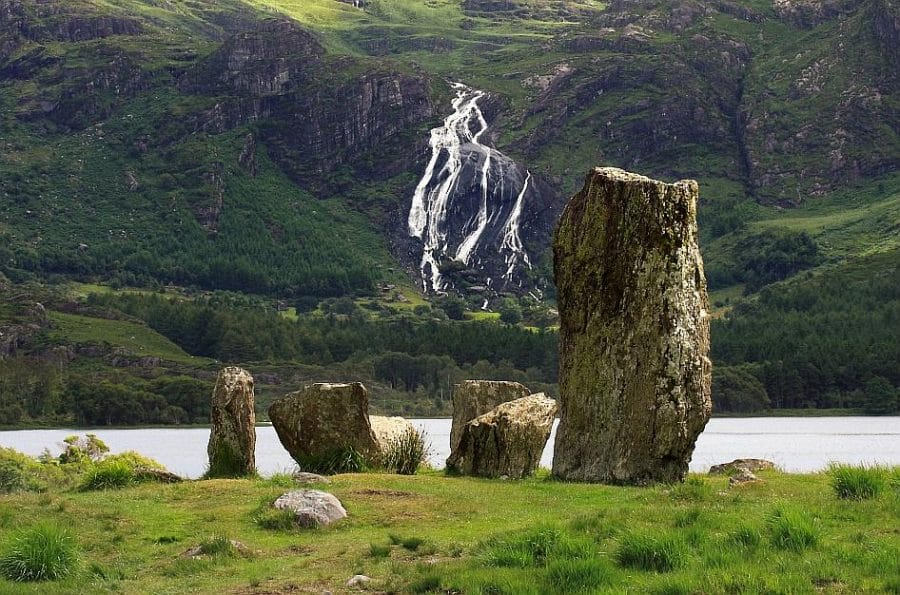
Location: In the south-west of County Cork on the Beara Peninsula.
Our list of the most impressive prehistoric stone circles in Ireland has to start with The Uragh Stone Circle. This stone circle is located in the idyllic Glen Inchaquinn valley between Kenmare and Lauragh. The monument consists of a circle of five stones and an additional three meter high stone that dominates the appearance.
Enclosed by wooded mountainsides and surrounded by lakes, a visit to the Uragh Stone Circle will take you to one of the most beautiful spots in Ireland. A few meters from this monument runs the Beara Way, a 152km (94 mile) long long-distance hiking trail.
The stone circle of Grange
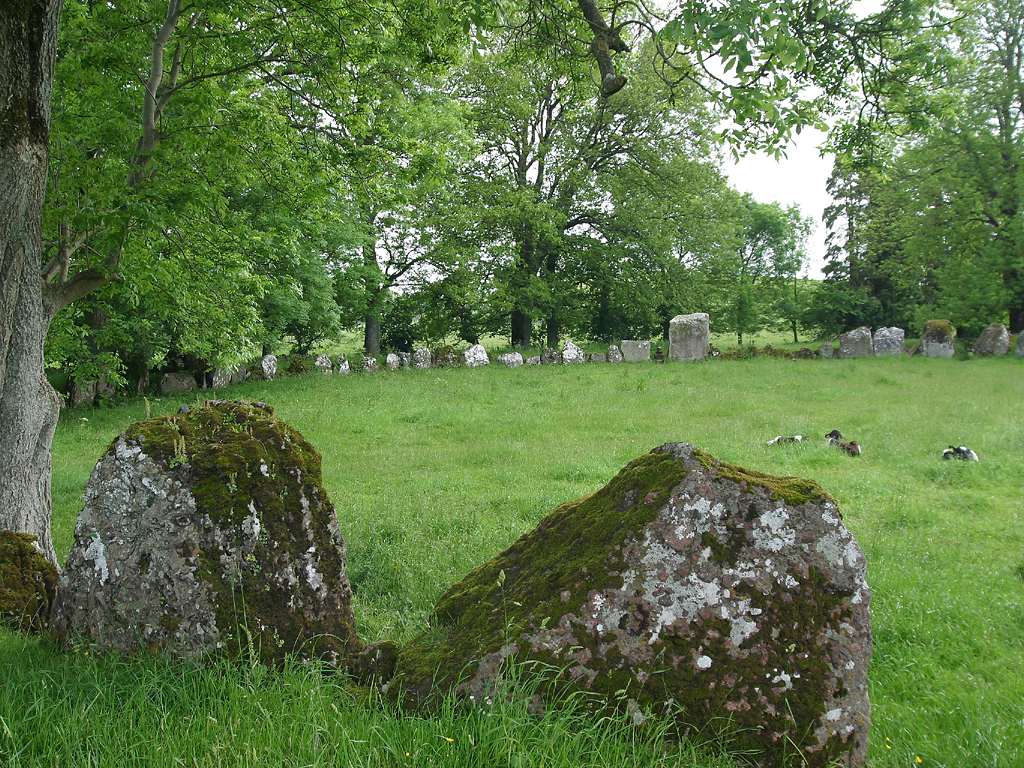
Location: In Bruff, 20km south of Limerick. Close to Lough Gur.
The Grange Stone Circle is the largest stone circle in Ireland at 45 meters in diameter. It consists of 113 upright stones. One of these stones weighs an impressive 40 tons, is four meters high and even has a name: Rannach Chruim Duibh (rough translation from Irish “the division of Crom Dubhs”).
During excavations, a post hole was found in the center of the stone circle. Archaeologists concluded that the stone circle was constructed with a rope tied to a pole, like a compass. The stone circle is also enclosed by an earth wall and thus resembles extensive enclosures, another type of prehistoric monument.
Are you interested in Irish archeology and the visible traces of Ireland’s thousands of years of history?
Read all about the 6 best prehistoric sites in Ireland here.
The Carrowmore Stone Circle
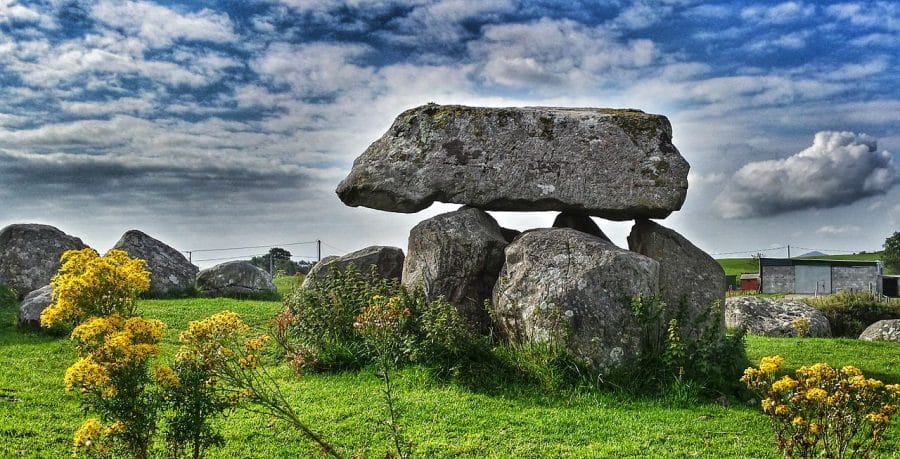
Location: In the north-west of Ireland, in County Sligo near Knocknarea.
Carrowmore is an extensive archaeological site with a total of more than 60 megalithic tombs, stone circles and standing stones. The attached visitor center offers guided tours where you can learn all about the area’s 6,000-year history.
At the center of the most famous Carrowmore stone circle is a grave made up of several stone blocks. Carrowmore overlooks the barrow of the legendary Queen Medhbh. Located high up on a slope, it can be seen from all sides and characterizes the landscape around Sligo.
Beltany stone circle
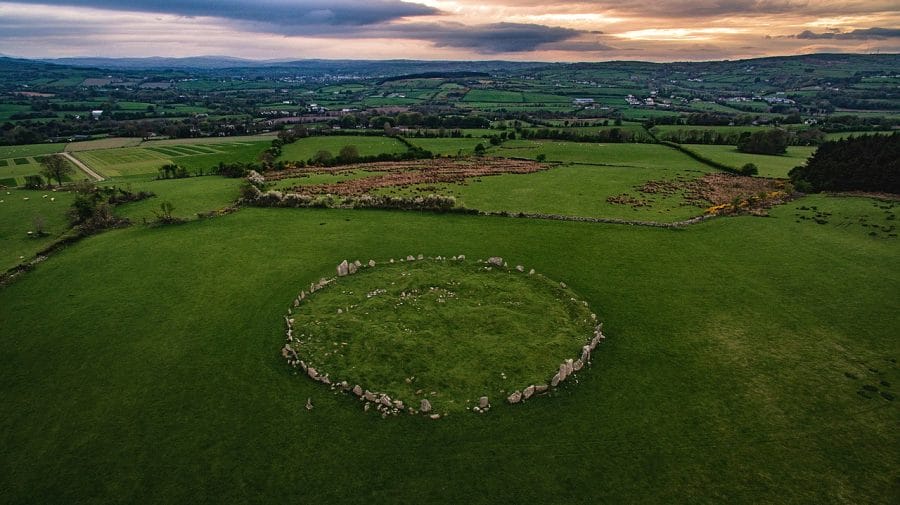
Location: In the north of Ireland in County Donegal, south of Raphoe.
The Beltany stone circle in Donegal gives archaeologists cause for speculation. In its center are the remains of a stone mound, which is atypical and suggests some researchers that the accumulated stones are the remains of an older, huge monument, such as a burial site.
Another unusual element around the Beltany Stone Circle is the statue of a head carved in stone. It is believed that various rituals took place at this point. In any case, the name Beltany is associated with Bealtaine, the festival that marks the transition from spring to summer.
The Ardgroom stone circle

Location: On the Beara Peninsula in County Cork, just past the village of Ardgroom.
The Ardgroom stone circle is on private land, but thankfully the local farmer and his sheep allow visitors to marvel at the monument. Also worth seeing is the landscape that surrounds the Ardgroom stone circle: sweeping ocean views of Kenmare Bay and the Beara Peninsula. This location truly makes it one of the best prehistoric stone circles in Ireland to visit.
Perhaps the magic of this place touched people thousands of years ago when they chose this piece of earth as their burial site. The remains of a person have been found here and archaeologists are debating whether it was a high-ranking leader from that time.
The Cashelkeelty stone circle

Location: Just before the small village of Lauragh, on the Beara Peninsula in County Cork, just 7km from the Ardgroom stone circle.
The Cashelkeelty stone circle is surrounded by a secluded forest on one side and a rugged mountain slope on the other. If you want to see it, head west of Lauragh and park on the R571 near the forest. Anyone walking on the Beara Way is automatically led to this enchanting monument, because the stone circle is literally on the way.
The unusual thing about the Cashelkeelty stone circle is that there is a second monument made of stones in the immediate vicinity. This is interpreted as a row or as a second stone circle, but since stones are missing in both structures, both the original function and arrangement are difficult to determine clearly. Visitors pay their respects to the monuments by leaving small coins and offerings.
The Drombohilly stone circle

Location: Between Lauragh and Tuosist on the Beara Peninsula.
Just six kilometers from the Cashelkeelty Stone Circle is the Drombohilly Stone Circle. The exceptionally high density of prehistoric structures make West Cork and the Beara Peninsula the hotspot of the stone circles in Ireland and an ideal travel destination for anyone interested in archeology.
The Drombohilly stone circle consists of nine stones, but it is believed that there were once eleven. One of the missing elements is the “Axis Stone”. These stones lie on their side while all other stones stand upright and are often directly opposite the tallest stones. The highest stones are interpreted as the entrance to the stone circle and are called “portal stones”. The Drombohilly stone circle consists of thin stones that run to a point. It is located on a kind of terrace and offers overwhelming views of the sea and the mountains opposite.
The Kenmare stone circle
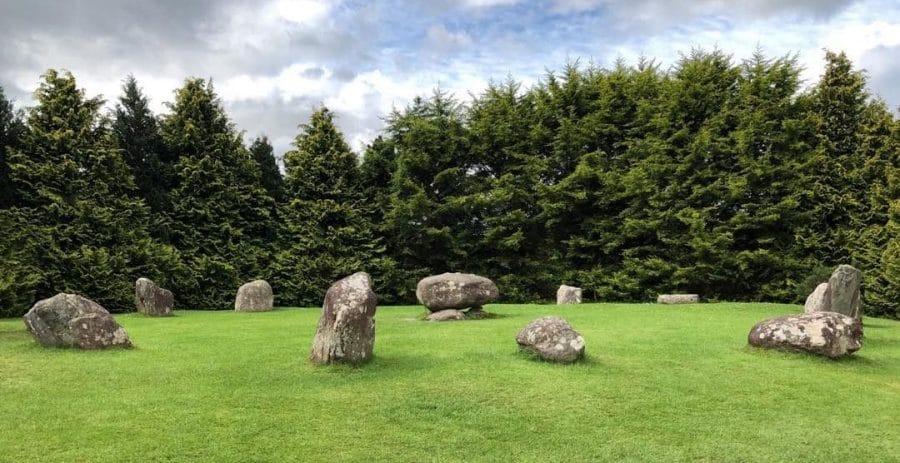
Location: 300 meters west of Kenmare, in the south-west of Ireland in County Kerry.
Although the Kenmare stone circle is close to the town itself, not far from the tourist information office, it is not easy to find. The district is known as “The Shrubberies”, or the bush in case you have to ask questions for directions.
Surprisingly, this stone circle is not round, but oval. At 17 meters in length, it is also one of the largest stone circles in the south-west of Ireland. As with the Beltany stone circle, there is a dolmen in its center. These stone formations are considered tombs and consist of stones on the side, which are covered by a large stone.
Kenmare is easily accessible by bus and car and is also a stop on the Ring of Kerry and the Kerry Way, Ireland’s longest long-distance footpath.
The Dereenataggart stone circle
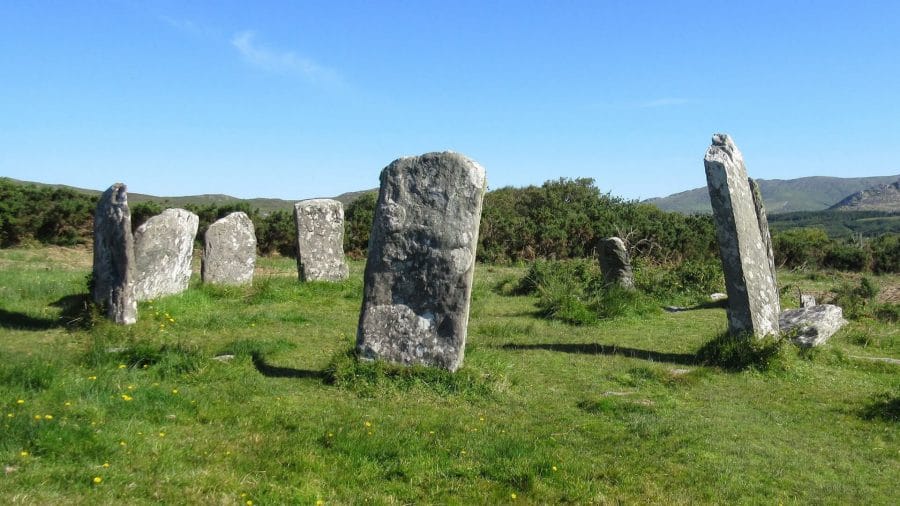
Location: 2km north of Castletownbere on the Beara Peninsula in West Cork.
The Derreenataggart stone circle is located in the middle of a cow meadow, not far from Castletownbere. Once again the Beara Way brings you directly to this impressive monument. Even if one of the portal stones has broken off and various stones are missing or overturned, this stone circle looks complete and radiates a pleasant calm.
One of the stones lies on its side, which is typical of the stone circles in the south-west of Ireland. The stones are sorted in descending order of size and get smaller and smaller from the portal stone to the lying stone. When the weather is clear, you can see the nearby Bere Island from here.
The Drombeg stone circle
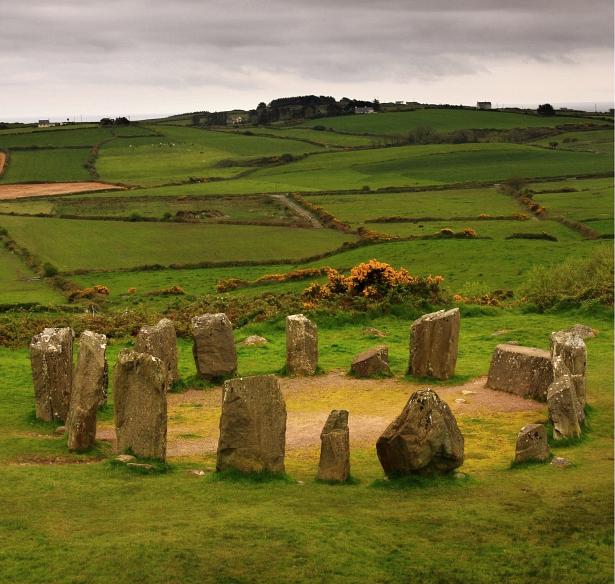
Location: In the south of County Cork, not far from Rosscarbery.
The Drombeg stone circle in the very south of the Emerald Isle is perhaps the most famous of the prehistoric stone circles in Ireland. Erected about 3,000 years ago, this monument is well preserved to this day. The reason for its fame is the fact that the skeleton of a youth was found here during excavations in 1950 and it is unclear whether he was sacrificed.
An anecdote that certainly contributed to the fascination of the stone circle can be found in Aubrey Burl’s book Guide to the Stone Circles of Britain, Ireland and Brittany. It says that in 1935 a clairvoyant visited the stone circle and had a vision of a blue-clad priest there. He was about to sacrifice someone who was lying on the stone lying on the ground.
The stone circle is popularly known as “the Druid’s Altar”.


